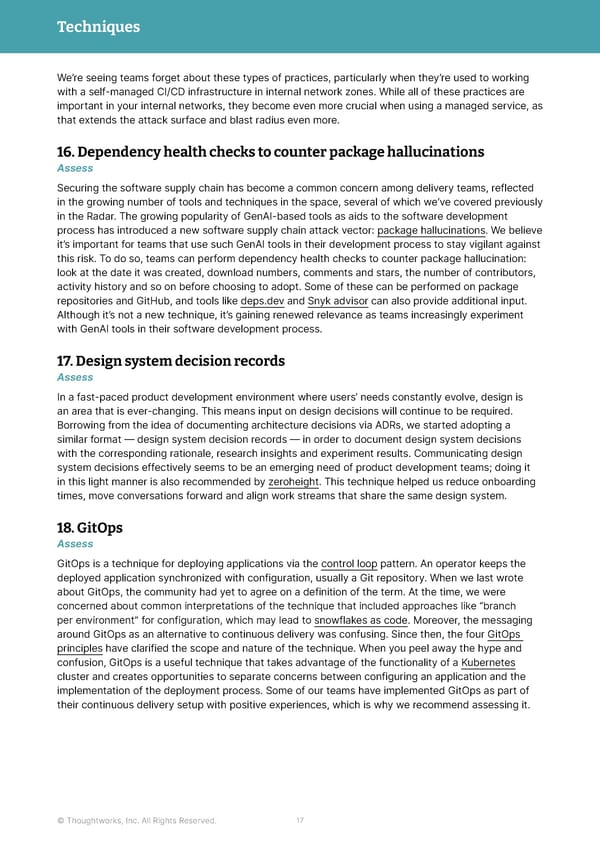Techniques We’re seeing teams forget about these types of practices, particularly when they’re used to working with a self-managed CI/CD infrastructure in internal network zones. While all of these practices are important in your internal networks, they become even more crucial when using a managed service, as that extends the attack surface and blast radius even more. 16. Dependency health checks to counter package hallucinations Assess Securing the software supply chain has become a common concern among delivery teams, reflected in the growing number of tools and techniques in the space, several of which we’ve covered previously in the Radar. The growing popularity of GenAI-based tools as aids to the software development process has introduced a new software supply chain attack vector: package hallucinations. We believe it’s important for teams that use such GenAI tools in their development process to stay vigilant against this risk. To do so, teams can perform dependency health checks to counter package hallucination: look at the date it was created, download numbers, comments and stars, the number of contributors, activity history and so on before choosing to adopt. Some of these can be performed on package repositories and GitHub, and tools like deps.dev and Snyk advisor can also provide additional input. Although it’s not a new technique, it’s gaining renewed relevance as teams increasingly experiment with GenAI tools in their software development process. 17. Design system decision records Assess In a fast-paced product development environment where users’ needs constantly evolve, design is an area that is ever-changing. This means input on design decisions will continue to be required. Borrowing from the idea of documenting architecture decisions via ADRs, we started adopting a similar format — design system decision records — in order to document design system decisions with the corresponding rationale, research insights and experiment results. Communicating design system decisions effectively seems to be an emerging need of product development teams; doing it in this light manner is also recommended by zeroheight. This technique helped us reduce onboarding times, move conversations forward and align work streams that share the same design system. 18. GitOps Assess GitOps is a technique for deploying applications via the control loop pattern. An operator keeps the deployed application synchronized with configuration, usually a Git repository. When we last wrote about GitOps, the community had yet to agree on a definition of the term. At the time, we were concerned about common interpretations of the technique that included approaches like “branch per environment” for configuration, which may lead to snowflakes as code. Moreover, the messaging around GitOps as an alternative to continuous delivery was confusing. Since then, the four GitOps principles have clarified the scope and nature of the technique. When you peel away the hype and confusion, GitOps is a useful technique that takes advantage of the functionality of a Kubernetes cluster and creates opportunities to separate concerns between configuring an application and the implementation of the deployment process. Some of our teams have implemented GitOps as part of their continuous delivery setup with positive experiences, which is why we recommend assessing it. © Thoughtworks, Inc. All Rights Reserved. 17
 Thoughtworks Technology Radar Page 16 Page 18
Thoughtworks Technology Radar Page 16 Page 18